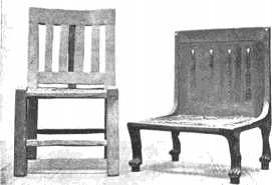Stare, sit and get conquered – the simple logic to a comfortable chair. All furniture designers struggle to realize and understand this lucid thought. And, it sure is a complex process to those who have delved deep into designing a successful chair.
With the emergence of the idea of anthropometry or what they call the science of understanding human dimensions; the design for a chair has evolved into a process in itself. However, before a designer invests their time and energy in this process, it becomes imperative to understand how the idea (of a chair) developed and the varied types that emerged all along.
Let’s begin with the Egyptians:
A chair is created to support sitting. Its beginning in the western world can be traced to the Egyptian civilization in and around 3000 BC. The chairs were developed to support the squat sitting position. Thus, the piece was at a lower height, to support sitting with ones’ legs hanging down. The stool appears to have been the most commonly designed piece of furniture.

With the emergence of the second dynasty, the stool was reformed for the higher classes. And, an authoritarian seating was introduced with the low back rest supporting the pelvis and sacrum in a fixed orientation. However, for those who still embraced the folded legs sitting position, the same stool with low back rest was reformed with a larger seating area.
Then came about the idea of footstools or as the contemporary world knows it, the Ottomans. These weren’t upholstered and served the purpose of low tables to accommodate the amenities needed around a seating.
There were also slight references to pure aesthetics when single curved or double curved chairs were brought into use during this period. The later era called the Mesopotamian used the stools and chairs similar to the Egyptians but they preferred to stay grounded and hence used mats rugs or cushions to provide for the support. The Babylonian periods in Mesopotamia depicts the use of a high backed chair and table together for dining purposes. Tall and straight line designs were commonly prominent with almost absence of decorative qualities.
Getting sophisticated with the Greeks:

The reclining couches of the Greeks with footstools
The period of sophistication in lifestyle emerged well with the Greek civilization. The Greeks took to reclining as their most loved seating position. Hence, came the idea of couches that were both common to dining and sleeping. Lounging on single couches and eating from low tables became the most ardent activity for the Greek men. These tables were also designed to be pushed under the chairs after their use, making way to the early idea of space-saving furniture.
The use of benches was also common in the Greek culture. They used them in schools and theatres where philosophers or artists enthralled the audience. The designers and craftsmen of this period also produced a design that is referred to as the classic Greek chair. Inspired from the Egyptian thrones, the legs of such a setting were curved with a back support that was neither straight nor slanting. It offered a new support that swept across the back spine and shoulders.
These standards later formed the basis of seating design in the 18th,19th, and 20th centuries. From the 16th century, the design of a chair was closely related to the social context and taste of different classes. The design moved away from the heavy, angular shapes to lighter frames.
The chaise lounge was a development during this time; highly inspired from the earlier Greek couch. Comfort and posture support were emphasized upon through curved backrests, padded armrests and elaborate upholstery. The chair became a work of art and a sign of luxury.
Then cometh technology:
With the advent of new technologies, methods and materials the upholstery emerged as a designer in itself. The outline form of the chair was provided with soft padded edges, voluminous cushions and plush materials and hence the chair completely relied upon cushioned padding to provide the support.
Backrests rose up to support the sitter, the seat depth increased to allow a comfortable sitting position, and padded arm rests invite a tired leg or weary elbow.

Slumped, passive postures were invited by the chair, with some of the chairs actually being called comfortables. These chairs made use of spiral springs placed in the base. Spring makers worked together with the upholsterer, to develop new shapes and styles, some not too different to the lounge suites in use today.
It was from the beginning of the 20th century that architects began their role-play in chair design. They pursued the chair as a form detaching its functional components. New materials in the form of steel tube, wire and plywood paved way for creative innovations. The designs were more often abstract with reflections of personalities, culture and themes.
Marcel Breur, a protégé of the Bauhaus school made use of tubular steel, bent into smooth curves to imitate an earlier curved chair style. Breuer Elastic Cantilever chair of 1929 is a fine example of a modernized classic Greek chair. Charles and Ray Eames, famous American designers, perfected a plywood moulding technique which they used to develop their popular designs. These designs are representative of the type of chairs that sold well and were widely copied from the 1940’s to present.
Slowly and gradually, the chairs started losing out on their individuality and uniqueness. Each function and space demanded a typical chair. As mass production for machine-made chairs came into being, the chairs no longer took an essential space in the head of a designer unless thought about radically.
There were certain artists of the post-modernist era that saw chair as pure art but their creations mainly surfaced about as installations or exhibits and less of functional use.
The chair has seen its birth from just being a support on a rock in the prehistoric age to the elaborate couch or recliner of today. These days, the levels of seating are often dimensionally explored from floor cushions to high bar chairs. But again a chair will only be successful when you cannot stop indulging yourself into it.

From primitive stools to the pompous thrones of kings to the ergonomic chairs of the modern day its amazing how far this simple idea of a chair has evolved through the ages….That was a good read!!
That was brilliant! Never thought chair’s evolution have that very interesting history… And I truly enjoyed it. And now, for me, chair will not be just an ordinary thing to sit on…… Thanks for posting !!!
Really it’s a great posting.